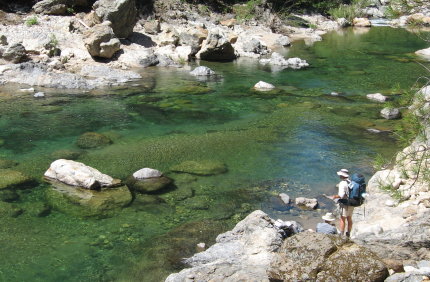
He burst forth from the river in a frenzy of excitement, water flying off like a shaking shaggy dog, shouting and gesturing wildly. What prompted this reaction, when moments before a lazy late summer afternoon at a deep pool along the Yuba River was the scene of quiet relaxation? Gold fever, that’s what. Whooping and hollering, Jim Pearson proudly displayed a gold nugget in the palm of his hand.
Eureka. The Golden State. The 49ers. Many words from the original California gold rush have made their way into everyday lexicon reflecting our rich mining heritage of the boom years of 1848-1855. Towns such as Placerville, Gold Bar, Rough and Ready, Jackass Gulch and Body reflect the rough and tumble camps that came with the rush, some destined to fade into obscure ghost towns, while others still thrive today.
Gold was first discovered in Coloma, a Sierra foothills town near Sacramento, at one of John Sutter’s lumber mills. Sutter, a pioneer poised to develop a huge agricultural operation, was distressed at the find, fearing that his plans would be disrupted. His fears were realized when workers deserted, running to the hills to get rich, and squatters stole his livestock and land.
Forty niners, the prospector’s named for one of the early years of the boom, faced a tough journey getting to California either by land or sea. Like many gold rushes, most toiled in vain, never realizing the fabulous riches of which fantasies are spun. Some did very well, including the so-called “forty eighters”, the earliest Argonauts, as well as merchants such as Samuel Brannan, who made a killing in San Francisco by buying prospecting supplies and selling them at a handsome profit.
In the early years the gold was readily available using low tech methods such as panning, where a shallow metal pan is used to agitate sand and gravel with water, which allows the heavier gold to settle while the lighter material can be discarded. Later, as more complex and costly technology was employed, such as hydraulic mining, dredging and blasting, mining became affordable by large corporations, rather than individuals.
With the price of gold up 140% (from $750/oz in October 2008 to $1050/oz in October 2009) since last year there has been increased interest in gold, from hobbyists to corporations. Gold mining claims at the US Bureau of Land Management for California has increased substantially in the last few years, from around 15,000 in 2005 to 24,000 this year.
When gold was first discovered in what is currently known as the state of California, the land was still part of Mexico, and was a generally lawless place. No permits were required or even available. Now however, on California rivers and streams almost every square inch of claimable land is staked. Be sure to check with local agencies to determine whether prospecting is allowed. In National Forest Lands, no permits are required for recreational “hands and pans” gold digging, provided no motorized equipment is allowed. Seasonal dredging permits can be obtained from the Bureau of Land Management. A number of parks offer information, gold panning demonstrations and opportunities to try your hand at panning.
The Local Angle

Along the Yuba River along the western foothills of the Sierra near Grass Valley and Nevada City mining operations are often evidenced by muffled explosions ricocheting off the rock walls lining the river bed, but locals know that gold can be had with a little patience and an eagle eye.
Jim Pearson, who grew up in Sacramento, remembers being intrigued by the possibility of finding gold in nearby rivers and streams as a young boy. Any outing to surrounding waterways involved keeping a sharp eye out for the glint of metal among the granite.
 Jim has developed a rather unconventional method of searching for gold in the deep pools found in many of the rivers of the areas, such as the Yuba River. Donning snorkeling gear he submerges his body in the cool waters of the snow fed river and scrabbles around with his hands looking for the lumps of gold and silver. According to Jim, “the areas where the water flows between large boulders creating eddies is a good place to look for gold because it lodges in the sand and silt buildup.”
Jim has developed a rather unconventional method of searching for gold in the deep pools found in many of the rivers of the areas, such as the Yuba River. Donning snorkeling gear he submerges his body in the cool waters of the snow fed river and scrabbles around with his hands looking for the lumps of gold and silver. According to Jim, “the areas where the water flows between large boulders creating eddies is a good place to look for gold because it lodges in the sand and silt buildup.”

On a recent backpacking trip in late summer Jim swung into action, affixing the mask and snorkel to his head, and sank into the water, warmed by the summer heat. After about fifteen minutes he sprang out of the water excitedly bellowing about his find. He proudly displayed his first find of the day, a small chunk of gold. Eureka! Spurred by success he disappeared under the surface over and over. Eventually he brought up a small lump of silver. A few hours later he had quite a collection of six good sized bits of gold and one lump of silver. Jim said a good time to look for gold in the rivers draining the high Sierra is after the spring runoff, when fast, deep water scours the deep pools and carrying the heavy nuggets to the lower elevations.
The lure of California gold remains real for many, and the precious metal is there for the taking.
Information:
Marshall Gold Discovery Historic State Park
Bodie State Historic Park
South Yuba River gold prospecting